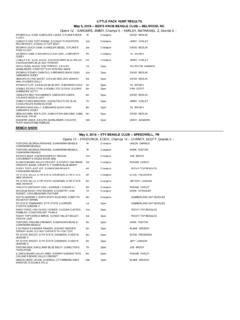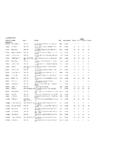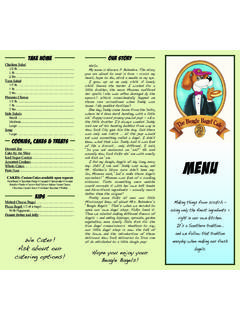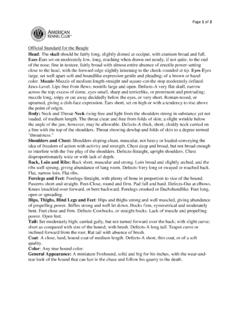Transcription of ARHA BEAGLE BENCH RULES AND PROCEDURES ALL …
1 ARHA BEAGLE BENCH RULES AND PROCEDURES . ALL DIVISIONS EFFECTIVE 08/07/12. Revised 08/12. I. BENCH Shows A. Policy Statement The ARHA believes that proper conformation is essential to the betterment of the BEAGLE breed. To this point, we will sponsor BENCH Shows to encourage the best possible conformation in a true hunting BEAGLE . The Judge is reminded that as hunting dogs they may show scars, cuts, and other signs of being in the field. B. The BENCH Judge shall not judge his/her own hounds, or any hounds that he/she has owned in the six months, prior to the show he/she is judging. Further, he/she shall not judge a hound that is owned by a member of his/her immediate family. Definition of immediate family: husband, wife, mother, father, son, daughter, brother, sister, or spouses of any of the above. Note: The date on the ARHA transfer papers is the official ownership date.
2 C. All BENCH Shows shall be judged by ARHA certified BENCH show judges who have been certified by passing the ARHA BENCH show qualifying test. 1. The BENCH Judge must be certified by ARHA for it to be a licensed BENCH Show. Any handler has the right to ask the Master of Hounds to have the BENCH Judge produce his/her ARHA BENCH Judge license. If the license is not produced the handler may file a protest with the Master of Hounds. 2. At regular sanctioned hunts, the head to head format is to be used for all classes (Open, Champion, and Grand). All hounds will be judged against the official breed standard, as adopted by the ARHA. Hounds shall be judged by standing all hounds in a class at the same time. In the Open class, the first place male, female, and puppy are to show against each other for Best of Show. 3. The club shall keep the BENCH Show Official Score Sheet for a period of 30 days after the hunt.
3 4. There shall be only 1 BENCH Judge for each class (Open, Champion, Grand) at each hunt. (Example: The same BENCH Judge must judge all of the Open Class. A different BENCH Judge can be used to judge all of the Champion Class & Grand Champion class and so on). D. Clubs must give awards to First Place Hounds and Best of Show Hounds in each class judged. They may give other awards. 1. Clubs must give awards to Second place hounds for Champion and Grand Champion Class Show at all Big Five/Six hunts. 2. Clubs must give awards to Second and Third place hounds in all classes shown at the World Hunt. All points earned toward championship while dog is a pup shall be carried over after dog is one year old. E. Classes shall be divided into: 1. Puppies six months to under one year old Classes 1 year and over: a. Open: Male/Female b. Champion c. Grand Champion F. Puppy BENCH Shows 1.
4 All puppies six months to under one year shall be shown against each other regardless of sex. 2. The Best Puppy shall compete against the Best Male Open and the Best Female Open for Best of Show Open Class. Note: A puppy that receives the necessary points and wins to be BENCH Champion will show against other BENCH Champions. This is also true for puppies that are Grand BENCH Champions. 3. Points shall be awarded as follows: a. Best Puppy 20 points b. Second Best Puppy 10 points G. BENCH Show - Open Class 1. Hounds shall be shown by sex 2. Points shall be awarded as follows: a. Best Male 20 points b. Second Place Male 10 points c. Best Female 20 points d. Second Place Female 10 points e. Best of Show 20 additional points 3. Only First Place Hounds shall be considered for Best of Show. 4. A BENCH Show Champion hound that has scored 100 points in BENCH Show competition and has received a minimum of 1 Best of Show Award.
5 Not more than 50 points may come from one club. H. BENCH Show Champion and Grand Champion 1. Since only Best of Show counts, Best of Show shall be the only place awarded with the exception of Big 5 or Big 6 Hunts. 2. A Grand BENCH Show Champion is a hound that has 3 Best of Show wins in Champion BENCH Show competition. One of these wins must be a State or Big Five or Big Six Championship. 3. A hound may also become a Grand BENCH Show Champion by gaining 5 Best of Show awards with no more the 2 coming from any one club. I. A hound must, be entered in the hunt to qualify to enter the BENCH Show. 1. Exceptions: a. Puppies b. Rabbit Champions and Grand Rabbit Champions may be shown on the BENCH without being entered in the field if no field class is established for them at that hunt. 2. A Handler may not pay fees and scratch the hound in order to compete in the BENCH .
6 The hound must take part in the field. If a hound is scratched by the Judge in the field, the hound is still eligible to be shown on the BENCH . No female in heat may be shown on the BENCH . J. Class Sizes 1. A minimum of 3 hounds must be entered and shown head to head in Open Class in order to award BENCH points. 2. Open Class shall be divided by sex. Example: 3 males are entered and shown, but only 2 females are entered and shown. Points are awarded to the male class, but not to the female class even if they are judged and trophies awarded. The Male winner or Puppy winner must receive Best of Show. If only 1 class of 3 hounds are shown, no Best of Show will be awarded. 3. A BENCH Champion Class shall be 3 or more hounds, regardless of sex, entered and shown. 4. A Grand Champion Class shall be 2 or more hounds, regardless of sex, entered and shown. 5. There shall be a BENCH Champion and BENCH Grand Champion Class at all State and Big Five hunts if there are enough entries.
7 6. A minimum of 3 puppies, shown head to head, constitutes a puppy class. K. Names of the Different parts of a BEAGLE : 1. Nose/Nostril 7. Occiput 13. Tail 19. Hip 2. 2. Muzzle 8. Neck 14. Rib Cage 20. Foreleg 3. Eyes 9. Chest 15. Loin 21. Elbow 4. Skull 10. Shoulders 16. Stifle 22. Knee 5. Ears 11. Withers 17. Hock 23. Feet 6. Lips 12. Back 18. Rump 24. Pastern L. BENCH Show entries shall close with Field entries. M. Time for BENCH Shows 1. If possible, a time will be designated during the day when all BENCH hounds shall be present and shown at one time. 2. This time shall be announced at the cast drawing. N. Licensed hunts only may award points toward a championship in any class. O. All protests from the BENCH Show shall be handled by the Master of Hounds. 1. Handlers are reminded that protests shall be over rule infractions only. The judging itself is all subjective and not open to protest.
8 2. Hound size shall be protested to the Master of Hounds. P. Any hound that has been neutered (castrated or spayed) shall be ineligible to be shown. A male BEAGLE must have 2 testicles of approximately the same size or it is ineligible to be show. Note: The two-testicle requirement does not apply to male puppies. II. BENCH Show Area A. ARHA Clubs should attempt to provide a large enough area to properly gait the hounds. B. ARHA Clubs should provide a stable BENCH . The BENCH on which the hounds are shown shall be at least 2 feet high and 18 inches wide, with the top covered with a non-slippery surface. The length of the BENCH should be of suitable length to hold a hound in a show position. If the BENCH does not meet the standard the judge shall allow the show to be held, but should instruct the Master of Hounds to have the situation corrected and notify the ARHA office that the BENCH does not meet the standards.
9 III. BENCH Show Judging A. Gait - A hound's gait is a valuable tool in locating possible faults. However, since points will be awarded in each specific area, no points are to be scored on gait. It is simply a recommended procedure for the judge to use to begin his assessment of the hound. With the head down in the trailing position, the back should be level; with the front legs moving straight forward with smooth minimal effort: Have the handler walk the hound at a comfortable pace the circle allowing the hound's nose to contact the ground in order that the hound may be observed m its natural trailing position. (Caution should be used here - the handler may be keeping too short a lead on the hound forcing an unnatural gait) This allows the judge to screen for the following: 1. Level Back (in the trailing position). a. A hound that is crouching will appear high in the back end while lower in the front.
10 This points to possible flaws such as a short neck and/or too long front legs. b. A hound that is roach backed will appear to be bowed up. This points to possible flaws such as disproportionate neck or front legs. 2. Swinging Front Legs - A hound that is swinging its front legs in a semi-circle points to possible flaws such as a chest that's too broad. 3. Bowed Legs - A hound that appears bow legged will have its elbows pointing outward while its toes point inward. (Bulldog look). 4. Bouncing Motion - A hound will appear to bounce up and down excessively. This points to foot and/or coordination problems caused by: 3. a. A weakness in the rear end such as thin hips or loin b. Being cow-hocked c. Being cat-footed (too high on toes). d. Being splay-footed (too flat on the toes). 5. Tottering - A hound will appear to be moving excessively from side to side. This points to a hound having its feet placed too far out from the body or too far under the body.













